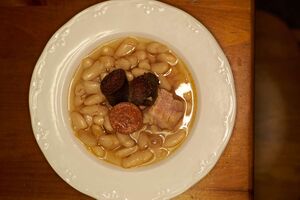Fabada
So beloved is fabada in Asturias that it is nearly impossible to find someone living here who does not eat it on a regular basis. Despite its relatively recent debut in Asturian gastronomy it is both the most loved dish in, and the most recognizable symbol of, Asturian cooking.[1] If someone knows a single thing about Asturian food, it’s fabada.
Fabada History
Most of medieval Europe ate some version of a perpetual stew. That is exactly what it sounds like:
…an ever-changing broth enriched daily with whatever was available. The cauldron was rarely emptied out except in preparation for the meatless weeks of Lent, so that while a hare, hen or pigeon would give it a fine, meaty flavor, the taste of salted pork or cabbage would linger for days, even weeks.
-- Tannahill, Reay. Food in History. Crown Trade Paperbacks, 1995
In Spain this was the olla podrida, the forerunner of fabada.[2] Descended from the Jewish adafina stew, it was popular across the Iberian peninsula.[3] It was described by Cervantes, through the words of Sancho Panza:
That great big steaming dish looks like olla podrida to me, and since that sort of hotchpotch stew has got so many different things in it, I can’t fail to come across one that I’ll like and will do me good.[4] -- de Cervantes Saavedra, Miguel, El ingenioso caballero Don Quijote de la Mancha (Parte II, Cap. XLVII)
Modern Fabada
Sometime in the 16th century, the medieval olla podrida began to change in Asturias. People replaced the chickpeas typical of the stew with white runner beans. People were then planting many more runner beans as garden crops in Asturias. With this, the final connection to adafina was severed, and the dish became the fabada we recognize today. Once it had been a stew of chickpeas, chicken meat and eggs. Now it was now a dish of white beans and pork sausages.
To the south, in Castilla y León, as well as elsewhere, Chickpeas continued to reign supreme. Even as the singular olla podrida fragmented into as many cocidos as there are regions of Spain, the chickpeas remained. Not in Asturias though. Here, once the fabes entered the pot, there was no looking back.
Fortunately, this is a recipe that is easy to make all over the world. Read on for how to make an authentic fabada at home in the US, or elsewhere. (astute readers might be interested in comparing that most American of all soups, Senate Bean Soup[5] to Fabada)
Ingredients
- 1 Compango. See notes for information on assembling a compango in the USA.
- 400 g fabes. See notes for information on acquiring or substituting for these beans.
- 1 small yellow onion, whole
- 3 cloves garlic.
- 1 bay leaf.
Instructions
- Cover the dried beans in plenty of water and soak overnight. The next morning, put the soaked beans into a large pot with your compango, onion, garlic and bay leaf.
- Bring the pot to a boil over high heat, then reduce the heat and gently simmer until the beans are soft. This can be anywhere from 45 to 90 minutes depending on the type of beans you are using, so please refer to your dried beans for this step.
- Once the beans are ready, remove the pot from the stove. Remove the sausages and meat from the stew and let them rest on a plate. Remove the onion and garlic and discard or reserve for another use.
- Now is the time for adjusting your seasoning. Add salt, pepper, and/or sweet paprika to the bean pot little by little, stirring gently after each addition and waiting several minutes to taste before deciding to add more. Once the seasoning is to your liking, you can let the stew rest for anywhere from one hour to a day or two (in the refrigerator of course).
- Cut the meats into generous chunks.
- Ladle beans into wide shallow soup bowls. Add broth and serve.
- It is traditional to serve the meats on a plate at the table so that each person can pick what they would like to add to their beans.
Notes
- For the compango you will need three things: smoked chorizo, smoked morcilla, and slab bacon. Please see this article for in-depth help on finding all the ingredients in the States.
- Asturian fabes are a protected food, but the US has two substitutes; one exact and one approximate. Read this article for all you need to know on substitute beans for this recipe.
- ↑ The first reference to Fabada as a restaurant dish is from 1884 in the El Comercio newspaper. – Méndez Riestra, Eduardo. Diccionario de cocina y gastronomía de Asturias. 2017 pp 258.
- ↑ from popurrí and the colloquial meaning of podrido: “having a lot of…”
- ↑ “…in the days of the Inquisition, when every man’s Christianity had to be restated daily if he were to survive, it became customary in Spain to ensure that there was always either pork in the cauldron or the dried pork sausage called chorizo hanging from the rafters as a sure proof that no Jew or Muslim lived or ate in the house.” – Tannahill, Reay. Food in History. pp 241. Crown Trade Paperbacks, 1995.
- ↑ “Aquel platonazo que está más adelante vahando me parece que es olla podrida, que por la diversidad de cosas que en las tales ollas podridas hay, no podré dejar de topar con alguna que me sea de gusto y de provecho”
- ↑ See this interesting article for a small history of, and the official recipe for, Senate Bean Soup, which to my eyes looks like Fabada with only ham.
